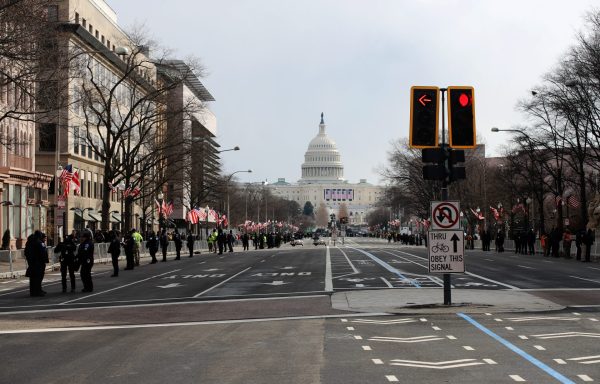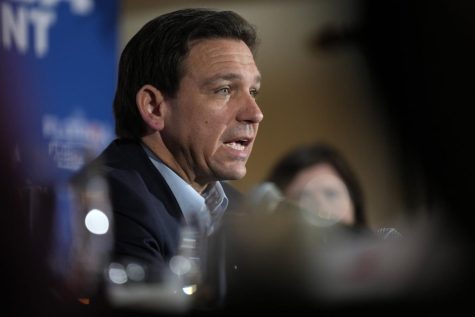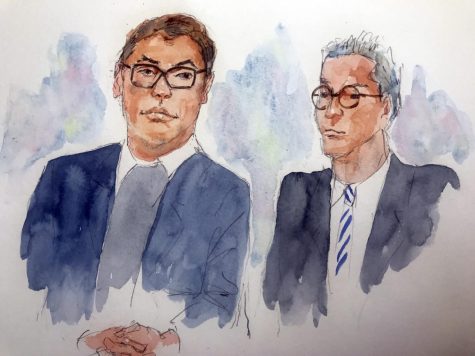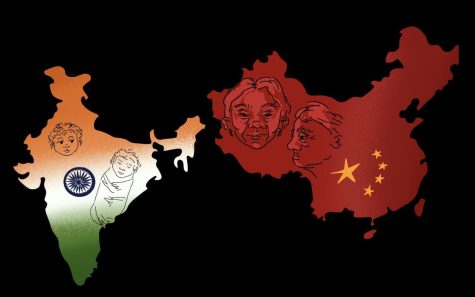New leadership for Japan: Shinzo Abe’s legacy and what to expect from the new prime minister
Then Prime Minister Shinzo Abe, left, and then Chief Cabinet Secretary Yoshihide Suga talk at a plenary session of the parliament’s Lower House in Tokyo in December, 2016. Japan’s Parliament elected Suga as prime minister Wednesday, Sept. 16, 2020, replacing long-serving leader Abe with his right-hand man. (Kyodo News via AP)
For the first time in eight years, Japan has a new prime minister. Yoshihide Suga, the 71-year-old son of a farmer, was elected via an internal party vote to replace Shinzo Abe, who is the longest-serving prime minister in Japan’s history.
Abe served a brief stint in 2006 and 2007 before resigning due to health concerns over ulcerative colitis, a chronic disease of the digestive system. After recovering, Abe was elected PM again in 2012, and he served until his resignation this year over concerns of the same chronic disease.
Abe leaves behind a legacy including Japan’s first period of sustained economic growth since 1991. His cumulative efforts to revive the world’s third-largest economy have come to be known as “Abenomics,” consisting of three “arrows”: qualitative easing, fiscal stimulus, and structural reforms. Critics have disputed the effectiveness of these policies.
The first of the three to be implemented was qualitative easing, under which the Japanese government reduced interest rates and the Bank of Japan increased inflation of the yen. Next came fiscal stimulus, including a 113 trillion yen stimulus package passed in 2013 designed to aid small businesses and fund public works.
“In order to make financial balance, [Shinzo Abe] increased the consumption tax, which was hugely unpopular in Japanese society,” said Taeju Kim, a professor of Japanese politics at the University of Chicago. “Big businesses got a lot of benefit, but the ordinary people were very much complaining about the consumption tax and paying for the big businesses to grow their business.”
The impacts of Abenomics aren’t as simple as that, though; along with an increased tax burden on the working class, Abe’s policies coincided with a drop in unemployment — below 3%, in fact — that’s remained steady ever since.
“I recognize [the low unemployment rate] is because the big businesses grew their business,” Kim said. “I certainly cannot deny the role his policy took in reviving the Japanese economy.”
Abe failed, however, to implement meaningful structural reforms, the last of his three arrows. A big part of the proposed reforms involved the Trans Pacific Partnership, which would have, among other things, closed some of Japan’s regulatory loopholes. President Donald Trump pulled the U.S. out of the TPP in 2017, undermining Abe’s plans for the trade agreement.
Along with his economic impact, Abe’s legacy is punctuated by nationalistic moves and public statements. Starting with his first term as PM from 2006 to 2007, Abe called for a revision of Japan’s constitution (commonly known as the “Peace Constitution”) which would eliminate Article 9 — the section forbidding Japan from having a military.
That revision never came about, though; moderate conservatives in Japan’s National Diet, its legislative body akin to the U.S. Congress, decried the expense of instituting an official Japanese military — especially when the American military already provides much of the same benefits.
“They wanted to appropriate American power, and then use it for Japan’s defense,” Kim said. “So Japan and the United States, they became inseparable.”
More than that, Japan’s fiscal health just can’t withstand the additional stress of having to fund a military budget.
“[Japanese legislators] wanted to focus on economic development, instead of being sucked into American wars,” Kim said. “So they used the Peace Constitution as a pretext to say, ‘You guys invented this Peace Constitution — because of that, we cannot go abroad and fight for you.’”
In fact, Kim said Abe likely knew full well that legalizing a military would be next to impossible politically and economically — in all likelihood, Abe had different goals in mind when he called for Article 9 to be dismantled.
“He’s a very smart politician, and some people might even say shrewd,” Kim said. “So he made a lot of efforts to look like it’s real, it has to look like it’s real. But he knows he cannot change the constitution.”
While his publicly-professed aims to repeal Article 9 never came close to fruition, Abe did usher in a reinterpretation of the Peace Constitution, allowing expanded use of Japan’s Self Defense Forces in allied-country military missions.
Abe maintained a nationalistic slant regarding Japan’s actions in the first half of the 20th century. He called for new Japanese history textbooks that were less self-critical of Japan’s imperialistic actions and war crimes.
Controversially, he also claimed in 2006 that there was “no evidence” Japan enslaved Korean women in brothels before and during World War 2, despite the Japanese government previously acknowledging and apologizing for it.
All indications point to Suga, formerly Abe’s chief of staff, continuing in Abe’s footsteps in many respects, including Japan’s relationship with South Korea, according to Kim.
“We should not expect that much change,” Kim said. “He is more moderate than Abe. The problem is Yoshihide does not have much power, because he does not have affection or support. So the basic line of foreign policy and economic policy, he’ll go with Abe’s line.”
Suga is expected to continue with Abe’s economic policies, though it’s unlikely he’ll be able to implement the missing “third arrow” of Abenomics: structural reform.
“He’s not an expert in economic reform, that is the first thing,” Kim said. “And second, I see the way he was elected was not through the whole party’s election system. It takes time and energy and also power in order to launch a structural reform, and Suga does not have that much political power.”
Lacking that crucial popular support, Suga isn’t expected to have the influence necessary to make waves in Japan’s economic structures. Thanks in part to the limited mandate, Kim said he sees Suga’s government as transitional and short-term.
“His role largely will be kind of managing the current Japanese political moment,” Kim said. “But I think Suga will be a very good manager.”
Assuming the Suga administration is indeed a short-lived one, there are some names to keep an eye on for Japan’s next prime minister election. Kim points to two, in particular. Shigeru Ishiba is seen as the strongest and most likely candidate, followed by Fumio Kishida.
“Last time he competed with [Shinzo Abe] in the first election, Ishiba won,” Kim said. “But in the second round, he lost because Abe was really good at factional politics. But in general voting, always [Shigeru Ishiba] is more popular.”
At his first press conference as prime minister, Suga emphasized the value of continuity in times of crisis.
“For all the people to restore peace to their lives, I will continue and push forward the Abe administration’s policies,” Suga said. “I recognize that is a mission given to me.”







